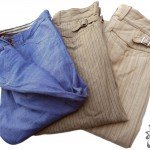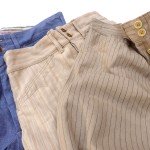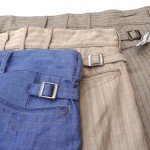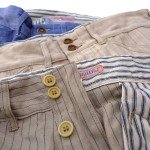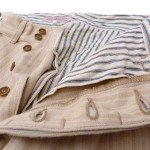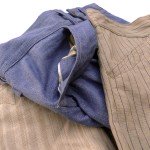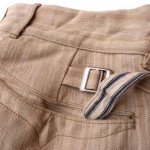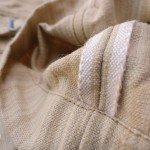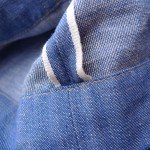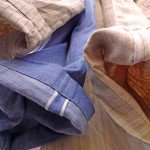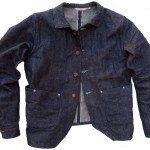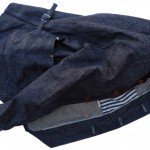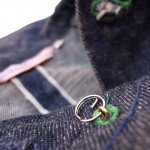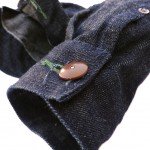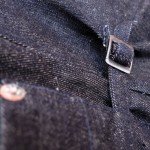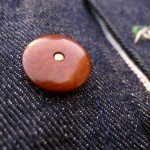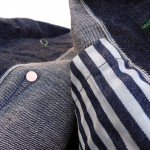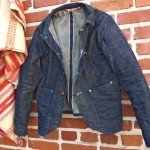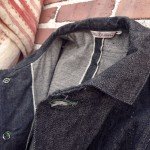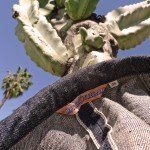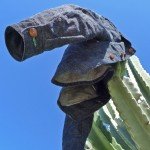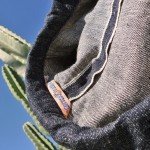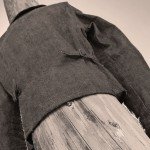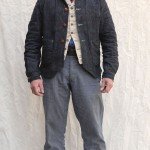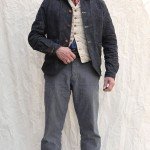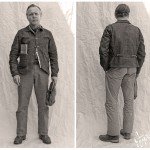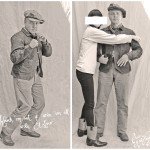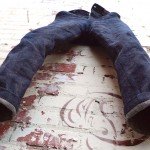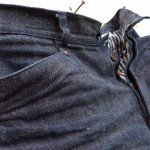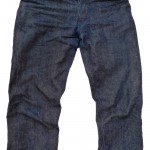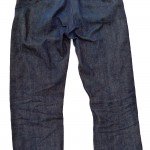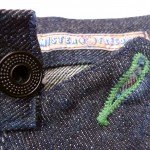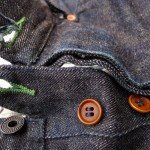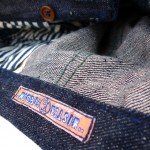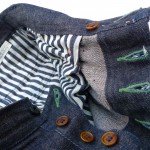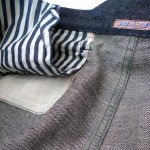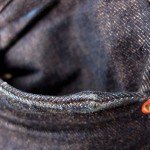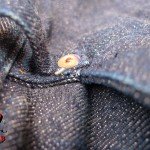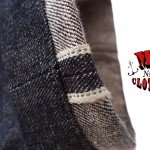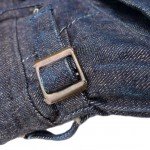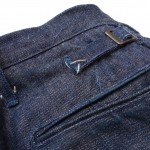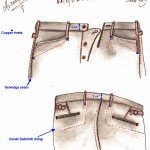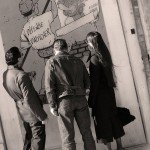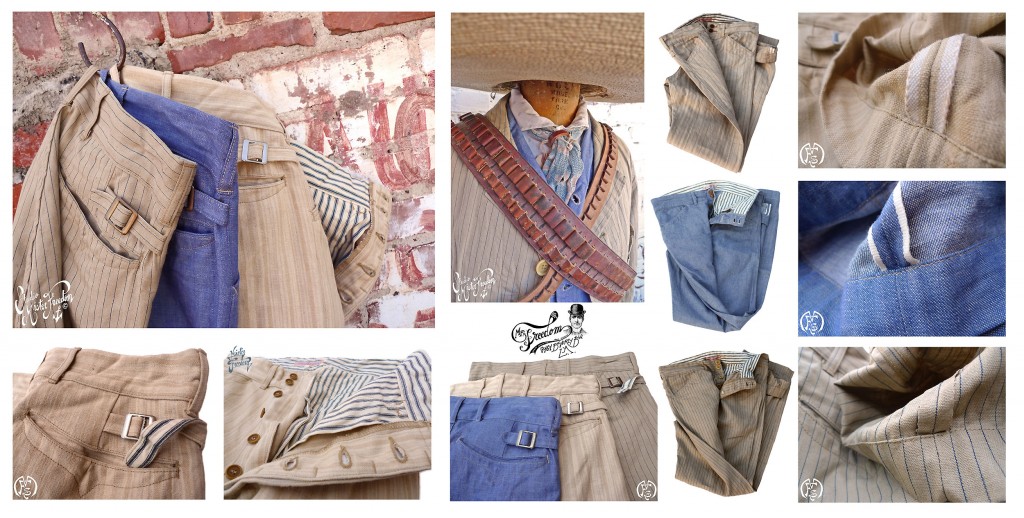
Mister Freedom® MFSC “HACENDADO Trousers”
‘Viva la Revolución’ Collection, Spring 2012
To complement our hacendado sack coat, here is the second part of the three piece suiting series for Spring 2013.
Inspired by several pattern of 1900’s to 1930’s slacks, the hacendado flat front trousers’ silhouette is reminiscent of classic 1920’s slacks, such as the tropical garb made by “Palm Beach Mills” (Goodall Company, Cincinnati, Ohio.) Vintage clothing aficionados might be familiar with that awesome label (see 1920 Ad below).
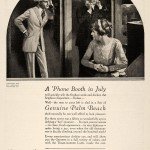
Our hacendado trousers come in three fabric options:
* Stripe: Tan and indigo dyed yarns plain weave pinstripe pattern, a crispy blend of 55% hemp and 45% cotton, 6.8 oz., solid tan selvedge, inspired by a textile swatch from a 1930′s vintage waistcoat.
* Homespun: Natural/earth tones dyed yarns plain weave textile, a heavier blend of 68% hemp and 32% cotton, 11 oz., solid white selvedge, inspired by a turn of the century homespun French textile from a vintage South-West of France farmer blouse.
* Baja Denim: Lighter shade indigo dyed denim, 2×1 twill, 100% cotton, 6.5 oz., inspired by a specific indigo shade typical of Mexican artisan dyers of the time, selected from several vintage textiles of the area.
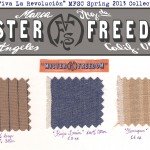
Again, wearing a matching set is definitely a statement, and mismatching the fabrics a good alternative. These trousers can also be paired with less ‘dressy’ clothes and footwear to tone them down, as often seen of period photography (out of necessity more than as a fashion statement.)
Cuffing options are up to you as well, I personally opted for a standard 1¼ fold with my own pairs.
All designed in California by Mister Freedom®, and manufactured in Japan by Sugar Cane Co. Limited edition.
SPECS:
* PATTERN: An original MFSC pattern, inspired by several vintage trousers from the 1900’s to the 1930’s. Elegant silhouette, for Gents not into skinny bottoms, or tights.
* FABRICS:
a) ‘Stripe’ option: 6.8 oz selvedge hemp/cotton woven textile. Body lined with inner ‘sandwiched’ (as opposed to a ‘floating’ lining) 100% cotton indigo dyed popeline. Arms lined with vintage 100% cotton NOS stripe plain weave fabric.
b) ‘Homespun’ option: 11 oz. selvedge hemp/cotton woven textile. Front panels lined with inner ‘sandwiched’ 100% cotton indigo dyed popeline (unlined rear panels for this option). Arms lined with vintage 100% cotton NOS stripe plain weave fabric.
c) ‘Baja Denim’ option: 6.5 oz. indigo dyed denim 2×1 twill, solid white selvedge, 100% cotton. Body lined with inner ‘sandwiched’ 100% cotton indigo dyed popeline. Arms lined with vintage 100% cotton NOS stripe plain weave fabric.
DETAILS:
* Higher rise, fit seat and fuller legs.
* Wide waistband with double button closure.
* Selvedge leg side seams.
* Thin belt loops, trousers style.
* “Italian” type front pockets, with fabric selvedge fold and early European arcuate decorative stitch.
* “Smiley” type rear welt pockets, with arcuate stitch. MF®, again putting a smile on your buns.
* Four button fly.
* Corozo wood buttons, aka ‘coconut wood’.
* Adjustable side cinch straps with French NOS metal slider buckles.
* MFSC stripe ticking 100% cotton waist lining and pocket bags. Fly facing with all cotton unbleached popeline.
* 100% cotton tonal stitching.
PACKAGING: An original MF® printed denim draw string bag, reusable as a grocery bag, hand-made in our Los Angeles studio.
SIZING/SHRINKAGE:
All three fabric options come RAW (unwashed). We recommend cold soak and line dry, which will result in minimal shrinkage and no color loss. All Hacendado trousers will ultimately shrink to tagged size. Fuller shrinkage will be obtained with gentle machine cycle and low heat dryer, at your own risks.
The hemp/cotton blends will retain the desirable wrinkle effect typical of linen type textiles and ‘tropical’ look.
The waist fit is ‘generous’, so if you are an actual 32” waist, get a marked 32 (see below fit pix of stripe hacendado trousers, waist 32, rinsed and hung dry, with extra Pelvis shot 😉
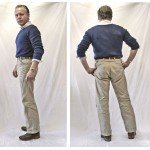
Refer to sizing charts below for approximate measurements:
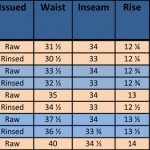 Baja 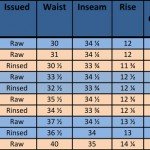 Stripe  Homespun Available RAW/Unwashed.
Waist SIZE 28, 30, 32, 34, 36, 38
(Length after rinsing 34”)
Retail $539.95
Call 323-653-2014 or email sales@misterfreedom.com to get yours while they last. We ship internationally to select Countries. As always, thank you sincerely for your support.
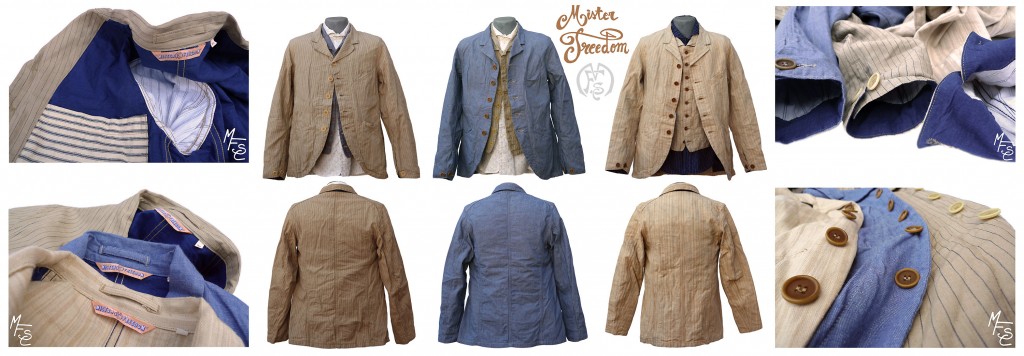
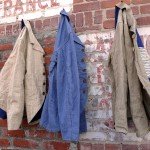 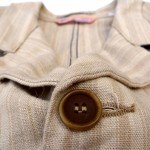 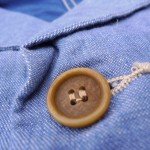 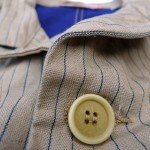 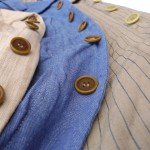 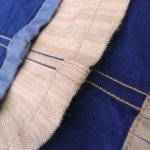 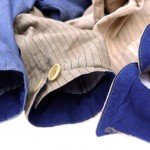 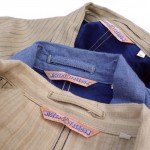 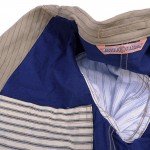 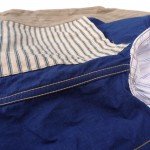 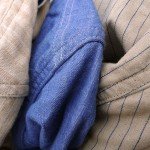
Mister Freedom® MFSC “HACENDADO” Sack Coat
‘Viva la Revolución’ Collection, Spring 2013
The Hacienda system in Mexico dates back to the Spanish conquistadores of the 16th century. Large estates (up to 25,000 acres at times) were granted to a chosen few hacendados by the Spanish Crown, along with the natives who had lived on it for generations. This inherited unjust structure mostly ended around 1917, after Villa, Carranza and Zapata got the best of most estates, burning and pillaging away during their campaigns. Land was somewhat redistributed to Indians and owners limited to 200 acres, following Zapata’s principle ‘la tierra es para quien la travaja’ (the land belongs to those who work it.)
Most wealthy hacendados lived in the Capital Mexico City, or Paris, and closed their eyes on how the often ruthless administrators ran the estate, fully enforcing their feudal rights on hundreds of peones.
Being well travelled and living the life, the hacendados sported fancy suiting made from imported fabrics. The styles were very much influenced by European tailoring, adapted to local needs, tastes and in typical ‘tropical’ fashion of old Mexico. When annually visiting their estate, high leather gaiters, fancy sombrero or fedora and fine silk neckwear completed the outfits…
As can be seen on period photography of ragtag fighters (see some examples below), a lot of these mismatched sack coats, trousers and waistcoats made it to the ranks of the Revolutionaries, as ‘souvenirs’ of haciendas’ looting. Nothing wrong in looking sharp in front of La Muerte, verda?
 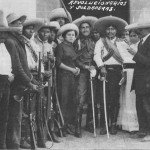 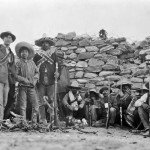 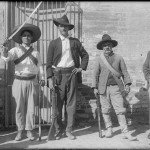 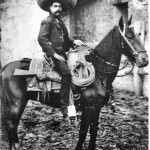
This is the background for our HACENDADO suiting serie for Spring 2013, again to take like a margarita, with a grain of salt por favor…
We have developed three very different fabrics for this concept, all milled in Japan exclusively for MFSC (see swatches here):
* Stripe: Tan and indigo dyed yarns plain weave pinstripe pattern, a crispy blend of 55% hemp and 45% cotton, 6.8 oz., solid tan selvedge, inspired by a textile swatch from a 1930’s vintage waistcoat.
* Homespun: Natural/earth tones dyed yarns plain weave textile, a heavier blend of 68% hemp and 32% cotton, 11 oz., solid white selvedge, inspired by a turn of the century homespun French textile from a vintage South-West of France farmer blouse.
* Baja Denim: Lighter indigo dyed denim, 2×1 twill, 100% cotton, 6.5 oz., inspired by a specific indigo shade typical of Mexican artisan dyers of the time, selected from several vintage textiles of the area.
Let’s kick it off with the “HACENDADO SACK COAT”.
The pattern is a take on our Faro Sack Coat from the “Men of the Frontier” Fall 2012 Collection, blending early European tailoring/suiting with a touch of American work-wear. The rounded curve of the front panels is typical of some turn of the century coats, and also common on some charro type shorter coats (as sported by the always dapper General Zapata.)
You’ll have the option to mix and match the different fabrics, typical of the period. Wear a three piece set or cleverly pair the hacendado gear with denim jeans or other pieces of your favorite daily pick.
All designed in California by Mister Freedom®, and manufactured in Japan by Sugar Cane Co. Limited edition.
SPECS:
* PATTERN: An original MFSC pattern, inspired by silhouettes of several late 1800’s and turn of the century wool coats, combined with some American railroad jackets elements.
* FABRICS:
a) ‘Stripe’ option: 6.8 oz selvedge hemp/cotton woven textile. Body lined with inner ‘sandwiched’ (as opposed to a ‘floating’ lining) 100% cotton indigo dyed popeline. Arms lined with vintage 100% cotton NOS stripe plain weave fabric.
b) ‘Homespun’ option: 11 oz. selvedge hemp/cotton woven textile. Front panels lined with inner ‘sandwiched’ 100% cotton indigo dyed popeline (unlined rear panels for this option). Arms lined with vintage 100% cotton NOS stripe plain weave fabric.
c) ‘Baja Denim’ option: 6.5 oz. indigo dyed denim 2×1 twill, solid white selvedge, 100% cotton. Body lined with inner ‘sandwiched’ 100% cotton indigo dyed popeline. Arms lined with vintage 100% cotton NOS stripe plain weave fabric.
DETAILS:
* High buttoned front style (five button front).
* Notch lapel, with indigo dyed popeline facing.
* Off set shoulder seams.
* Flat felled seam chain stitch construction. 100% cotton thread.
* One chest and two waist slanted welt pockets.
* Concealed stripe cotton MFSC ticking chest pocket.
* Genuine Corrozo wood buttons, matching tones.
* Adjustable double button sleeve cuffs.
* No exposed seams/ no overlock.
* Original MFSC woven rayon neck ‘hanging loop’ label.
PACKAGING: An original MF® printed denim draw string bag, reusable as a grocery bag, hand-made in our Los Angeles studio.
SIZING/SHRINKAGE:
All three fabric options come RAW (unwashed). We recommend cold soak and line dry, which will result in minimal shrinkage and no color loss. All Hacendado sack coats will ultimately shrink to tagged size. Fuller shrinkage will be obtained with gentle machine cycle and low heat dryer, at your own risks.
The hemp/cotton blends will retain the desirable wrinkle effect typical of linen type textiles and ‘tropical’ look.
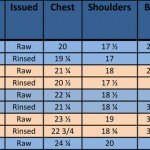 STRIPE option 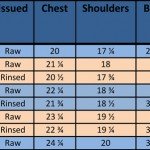 HOMESPUN option Available RAW/Unwashed.
SIZES
36 (small)
38 (Medium)
40 (Large)
42 (X-Large)
44 (XX-Large)
Retail $739.95
Call 323-653-2014 or email sales@misterfreedom.com to get yours while they last. We ship internationally to select Countries. As always, thank you sincerely for your support.
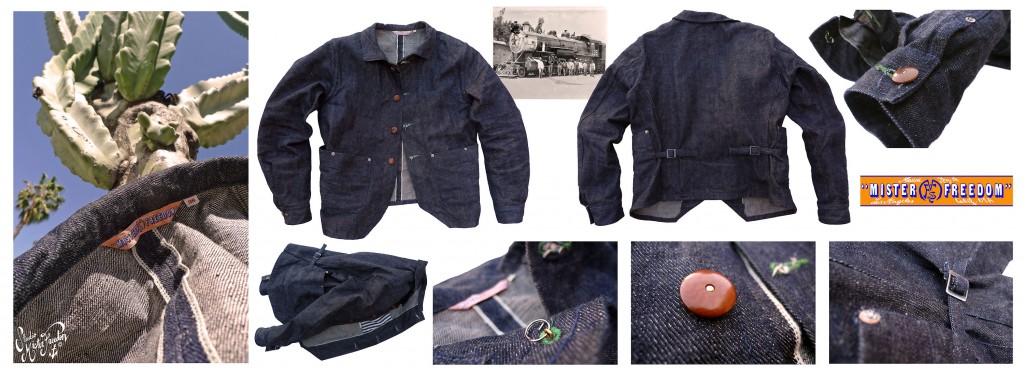
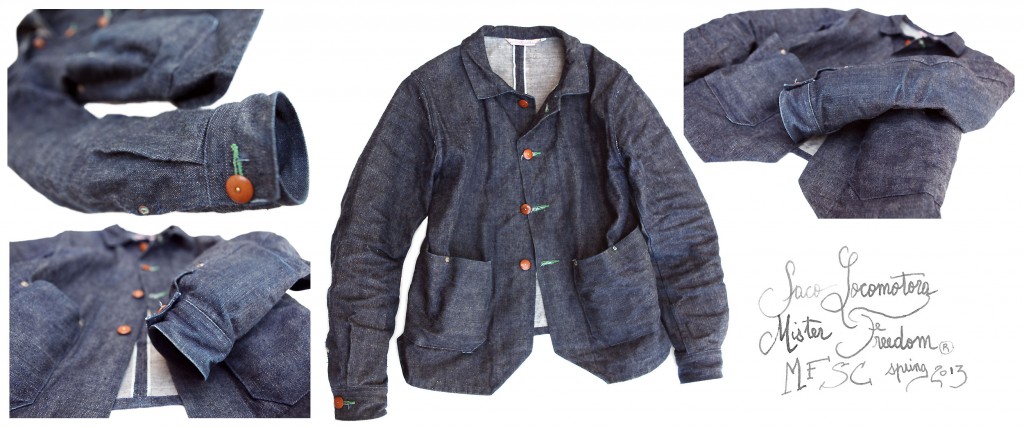
Mister Freedom® MFSC “Saco LOCOMOTORA”, made in USA.
‘Viva la Revolución’ Collection, Spring 2013
Hinting at an instrumental tool of the Mexican Revolution here is our SACO LOCOMOTORA, aka El Loco as we call it around here.
The railroad system in Mexico played a major part in the unfolding of the Revolution. Many folk songs (Máchina 501 for instance, or many other tunes played by la Banda Tlayacapan who accompanied General Zapata during the war) celebrate the key role of that modern mean of transportation. Trains allowed the speedy transport of troops to the front lines, turned hospitals on wheels with families tagging along, or were used as plain torpedoes loaded with explosives.
In 1911, Emiliano ‘El incorruptible’ Zapata met with Francisco Madero, freshly cheated of the National election by Porfirio Diaz, to discuss strategy for the fight to regain power.
The meeting place? Colonia railroad station, aboard Zapata’s famous steam locomotive No. 279, his headquarter since 1909. That historical steam Engine has survived and a restored version can still be seen if you take a trip down Cuautla way, State of Morelos, southern Mexico.
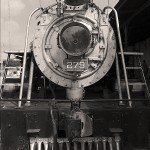 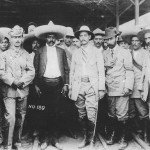 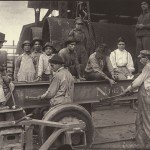
For our first ‘iron horse’ related garment, we designed a type of denim railroad jacket ‘from scratch’, keeping a ‘local artisan made’ feel to it. We combined elements of twill work-wear jackets, both from the Old and New World, resulting in a cross-breed between a European work coat and a classic American denim Railroad jacket.
We kept a shorter silhouette for El Loco, somewhat typical of period Charro suit jackets.
The deep side wrap copper-riveted pockets were designed to hold wrenches, rags, log books and various mechanic’s tools. They will also hold a wallet or an iPhone, should these prove more useful to you during the day 😉
The split back panel pattern displays the denim selvedge on the inside, which will result in ‘tracks’ (bada bing), naturally showing after repeat wear and sofa staining.
As with our Vaquero Blue Jeans, we are using an original indigo dyed left hand twill denim developed by Sugar Cane Co in Japan, referred to as “Okinawa 301“. It blends cotton yarn with recycled sugar cane fibers (50/50) in a strong, slubby, hairy, coarse denim twill, guaranteed to age beautifully.
The green accents of the button holes/eyelets are reminiscent of older American work-wear details, green also being a color not foreign to the Mexican National Flag.
We opted for corozo wood detachable buttons (aka ring buttons), a typical feature of early work and military coats, that allowed washing the garment without its hardware.
The collar shape and angle is a nod to turn of the Century patterns.
Using flat felled seams and single machine construction we had el Loco made in Los Angeles, California, as a collaboration with partner in crime Sugar Cane Co.
SPECS:
PATTERN: An original MFSC pattern. Designed by Mister Freedom® and combining elements of early work coats from Europe and USA.
FABRIC: Raw 14 Oz. indigo dyed selvedge denim, left hand twill. 50% cotton blended with 50% recycled sugar cane fibers. White selvedge with green ID line. Milled in Japan.
Note: For detail orientated folks, the collar facing is made of NOS 12 Oz. selvedge Cone denim, same fabric as the Californian Lot.54
DETAILS:
* Shorter silhouette.
* Six high button front style, allowing easy access to higher waist style trousers pockets. Detail also typical of horseback riding coats, allowing the jacket to ‘break’ at the proper place when fully buttoned.
* Single piece front panels, no shoulder yoke.
* Adjustable side cinch straps, with vintage NOS metal buckles.
* Corozo wood detachable ‘ring’ buttons.
* Green color button holes and eyelets.
* Deep wrap pockets, double compartment.
* Concealed left chest pocket, made of NOS stripe cotton twill.
* Selvedge used in split back, button front panel/pockets/cuffs facing.
* Single needle and chain stitch flat felled seams, with 100% cotton tonal thread stitching.
* Designed and Made in the USA.
PACKAGING: An original MF® denim bag, made in our studio, to sling around for your next trip to the local organic Farmer’s market.
SIZING/SHRINKAGE:
The “Okinawa 301” denim is RAW and unsanforized. Overall shrinkage from rinsing/washing should be about 5% to 8%, according to water temperature. This fiber denim will shrink with an original cold soak and line dry. It will expand a bit again with wear, then shrink again with subsequent rinsing. This normal evolution should settle after a while.
El Loco will shrink to TAGGED size.
We recommend an original cold soak (about 30mn, no agitation), spin cycle and line dry. This will get you minimal shrinkage and retain ~100% of the indigo color. Some bleeding is expected with normal wear (from blue hands to blue armpits. Indigo bleeding will wash off.)
As always, boiling is not recommended (too much color loss), just get your size.
Remember that you will not get beautiful patina from extensive unneeded washing, but rather from repeat wear.
I usual wear a 38 (Medium) in all mfsc jackets, and I wear a 38 in this denim coat.
Note: The photos above are from a slightly worn jacket, showing very minimal wear after an original cold soak. Production is UNWORN and raw.
Please refer to sizing chart below for approximate raw/cold soak measurements:
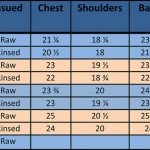
Available RAW/Unwashed.
SIZES
36 (small)
38 (Medium)
40 (Large)
42 (X-Large)
44 (XX-Large)
Retail $439.95
Call or mail sales@misterfreedom.com at 323-653-2014 to get yours while they last. We ship internationally to select Countries. Thank you for the support, Señoras y Caballeros.
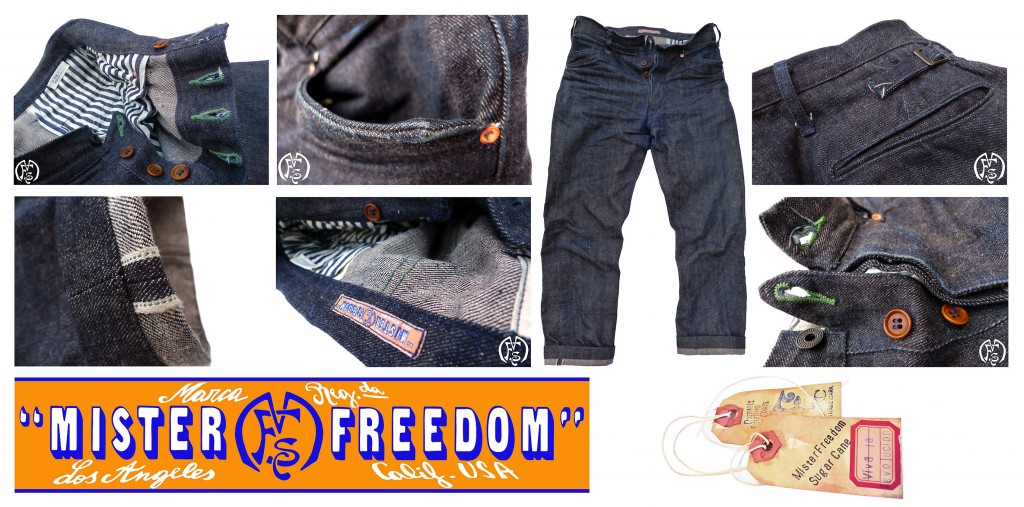
Mister Freedom® MFSC “VAQUERO Blue Jeans”, made in USA.
‘Viva la Revolución’ Collection, Spring 2012
For the background story about this collection, read this first and proceed if I haven’t put you to sleep.
Early settlers of the old West adapted the Spanish word vaquero to buckaroo when referring to cowhands and horsemen.
Because of the ever presence of the European influence in Mexico in the 1800’s and 1900’s, we have opted for a pair of work pants pattern with details borrowed from tailor shops of the Old World. Our Vaquero Blue Jeans are constructed like early European trousers rather than like a five pocket type often associated with later cowboy pants. These features include side cinch straps, flared waistband, inside waist button flap, back welt pockets with reinforced facing, narrow width belt loops, no back yoke, open bottom hem…
The front pocket opening is a nod to Charro and Chinacos type trousers, with a flap somewhat similar to later western type pants.
The green color stitching hints to several work-wear brands that used green thread for bar tack or button holes (such as the Kansas brand Key Imperial Overalls, since 1908.)
We are using tonal stitching, giving the Vaquero its slacks appearance and a clean silhouette. The copper riveting on denim and selvedge side seams pull it back into work-wear type cowboy pants.
The fabric we chose is an original indigo dyed left hand twill denim developed by Sugar Cane Co in Japan, referred to as “Okinawa 301“. Not a cheap choice (being a very expensive process and therefore fabric) but well worth it for the textile connoisseurs. It blends cotton yarn with recycled sugar cane fibers (50/50) in a strong, slubby, hairy, coarse denim twill. After about 20 years (!) of R&D, Sugar Cane was able to perfect this magnificent denim twill that has won the hearts of hardcore denimheads because of the way it beautifully ages and fades. Now if that’s not a sales pitch…
Side note: This fabric is somewhat sentimental to me, as this was the denim I picked for the left leg of the “7161 Utility Trousers”, our first ever MFSC collaboration with Sugar Cane Co back in 2006.
MF® ol’ timers will remember these dungarees, aka ‘Frankenstein jeans’ (3 different denim/pair, sloppy stitching and a very weird original pattern)
48 raw pairs were sold in the USA (see photo below)…
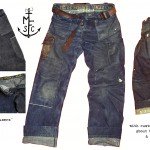
The “Vaquero Blue jeans” are designed in California by Mister Freedom® and manufactured in Los Angeles as a collaboration with Sugar Cane Co.
SPECS:
PATTERN: An all original MFSC pattern, inspired by early European trousers, mixed with American cowboy pants.
FABRIC:
Raw 14 Oz. indigo dyed selvedge denim, left hand twill. 50% cotton blended with 50% recycled sugar cane fibers. White selvedge with green ID line. Milled in Japan.
Pocket bags: NOS all cotton stripe twill, USA.
Seat lining patch: white cotton sailcloth.
Note: TMI alert, for detail orientated folks, the inside button hole fly piece is made of NOS 12 Oz. selvedge Cone denim, same fabric as the Californian Lot.54
DETAILS:
* Trousers construction
* “Cowboy” front pocket opening
* Back welt pockets
* Side cinch straps, with NOS vintage French metal buckles
* Selvedge leg side seam
* Open bottom hem, for your cuffing discretion (hemmed, double hemmed, rolled…)
* Unmarked copper riveting
* Concealed accent with green thread button holes and inside chain stitch
* Flared waistband (narrower in back)
* Slim belt loops (trouser style)
* NOS stripe twill pocket bags and cotton sailcloth seat facing
* Early type ‘donut’ metal waist button, brown corozo wood fly buttons
* All cotton thread tonal stitching
PACKAGING: An original MF® denim bag, made in our studio, to sling around for your next trip to the local Farmer’s market, or Torreón.
SIZING/SHRINKAGE:
The “Okinawa 301” denim is RAW and unsanforized. Overall shrinkage from rinsing/washing should be about 5% to 8%, according to water temperature. This fiber denim will shrink with an original cold soak and line dry. It will expand a bit again with wear, then shrink again with subsequent rinsing. This normal evolution should settle after a while.
The Vaquero will shrink to TAGGED size.
We recommend an original cold soak (about 30mn), spin cycle and line dry. This will get you minimal shrinkage and retain ~100% of the indigo color. Some bleeding is expected with normal wear (from blue hands to blue whatever-is-tucked-in. Indigo bleeding will wash off.)
I am usually between a waist 30 and 32 with MFSC trousers/jeans, and I am wearing a 30 in the Vaquero Blue Jeans. Do not size up unless you really need the extra room. As always, boiling is not recommended (too much color loss), just get your size.
Remember that you will not get beautiful patina from extensive unneeded washing, but rather from repeat wear.
Note: The photos above are from a slightly worn pair, hemmed, showing minimal wear after an original cold soak. Production is UNWORN and raw.
Please refer to this sizing chart for approximate raw/cold soak measurements:
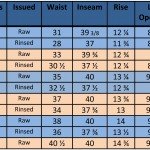
Available RAW/Unwashed.
(Tagged/will shrink to) Waist SIZES 28, 30, 32, 34, 36, 38
Inseam: Approx. 40 inches (open hem)
Retail $379.95
Call 323-653-2014 or mail sales@misterfreedom.com to get yours while they last. We ship internationally to select Countries. Thank you for the support, Señoras y Caballeros.
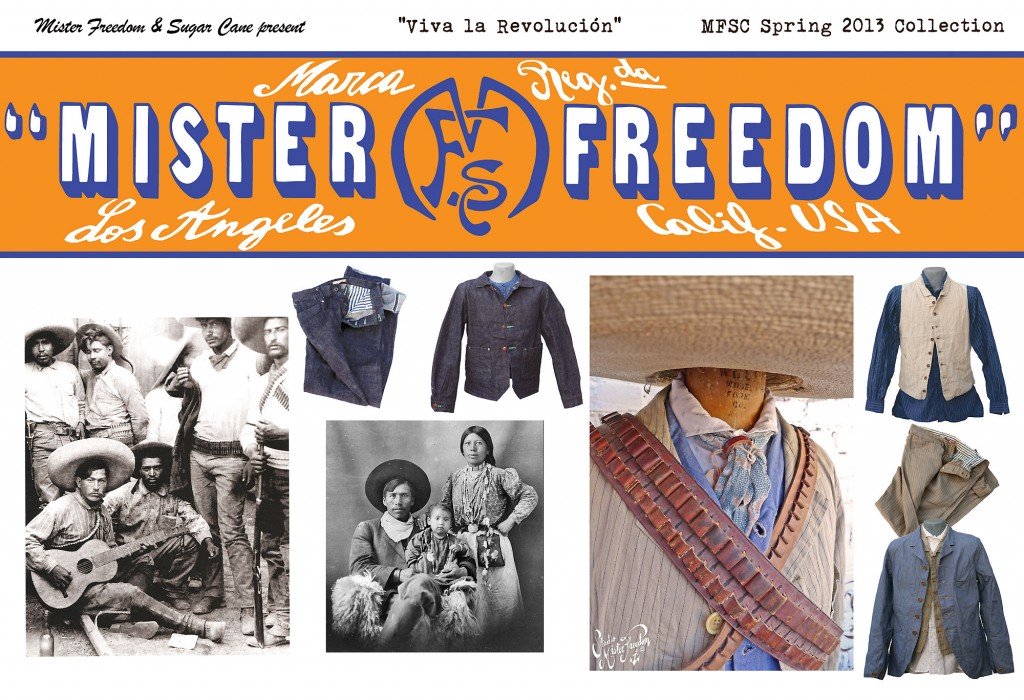
“VIVA La REVOLUCIÓN” Collection
Mister Freedom® x Sugar Cane MFSC Spring 2013
As one might have suspected from the title of our latest Mister Freedom® x Sugar Cane collection, our new venture will be taking us ‘South of the Border’, on the set of the “Mexican Revolution”, commonly referring to the brutal civil war that took place in Mexico, starting in 1910 and ‘settling’ around 1920.
I quickly realized I knew very little of it, save for a few cliches of its iconic leaders (Villa, Zapata…), some songs (La Cucaracha with its puzzling lyrics) and silhouettes (large sombreros, serapes and loaded bandoleers) mostly borrowed from Sergio Leone’s flicks… But learning that at the turn of the 19th century about 1000 men owned most of Mexico, the majority of them foreigners, leaving some 97% of the population wondering why, was a promising scenario for a fascinating slice of History.
Like with any major social uprising, the Mexican Revolution was a very complex succession of events. They led to an 80 year old foreigner-friendly Dictator Porfirio Díaz being thrown, Democrat Francisco Madero elected, then assassinated… Ensued somewhat of a Comandantes musical chair drill for power… and social and constitutional changes that continued beyond that decade to shape modern Mexico.
Alliances, treason, bravura, determination, politics & religion, sacrifices & intrigues blended in a confusing saga that has many historian disagree on what really happened, and how. Scholars even disagree on the total human cost, quoting the blood bath toll at 1 million, all the way to 3.5 million, according to their interpretation of the events.
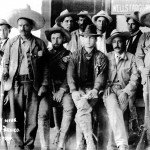 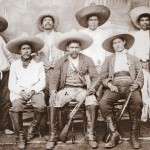 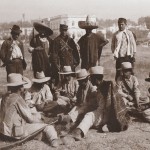
Due to deeply rooted foreign investments in Mexico and International involvement in land ownership and politics, these ‘South of the Border’ events unfolded under the watchful eyes of the World leaders. International Media, along with Foreign Secret Services were on it like lead paint. This would be one of the most documented modern revolution. Commissioned photographers, writers, journalists, motion picture crews, foreign advisors and undercover agents were dispatched… The US-Mexican Border was a media circus, and the rest of Mexico was in no less of a confusing mess.
Here are some random parts of the ‘magic formula’ that contributed to what went on, some one hundred years ago:
– Germany, who had been courting Mexico for years, patrolled the coast with Imperial Navy ships, gathering intel on how prepared the US would be in the event of a European conflict. (In 1914, witnessing that American sailors had to dye their white summer uniforms with coffee grounds for camouflage was a hint that the US needed more time.)
– Anxious US diplomats thrived to play the right cards, and feared betting on the wrong horse.
– Counterfeiters generated practice targets for the Federales firing squads.
– Foreign mercenary troops from ‘neutral’ Countries were clearly spotted on battle fields.
– William R. Hearst unleashed his powers to dismiss the legitimacy of the Revolution in public opinion.
– General Francisco Villa starred in a silent movie filmed on location by an American bullet-dodging filming crew (sadly the movie “The Life of General Villa” never hit the screen, as most reels got ruined during transport back to Hollywood, supposedly.) If you get a chance, watch Gregorio Rocha’s “Lost Reels”, I missed that one…
For a captivating snapshot of early events, war correspondence like you were there, read John Reed “Insurgent Mexico” (1914), a fearless unarmed 26 year old American left-wing journalist who joined the ranks of the Cucarachas (as were nicknamed the troops on foot of the División del Norte, who needed funny cigarettes to keep trekking.) He survived to tell, just to die a few years later while documenting the Russian Revolution.
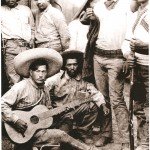 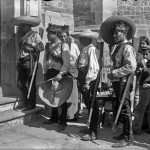 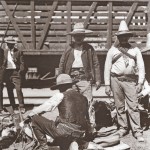
This season, we have drawn inspiration from period photography (the works of Gustavo Casasola, Robert Runyon…), from the silver screen’s vision of the Revolución… and, to be fair, from whatever is going on inside our little cabezas:
– A smiling galloping Maderista, wearing a three piece suit on donkey back (General Emiliano Zapata was himself quite the dresser, never to be seen in traditional calzón, but instead often decked out in fancy Charro suits.)
– A weary Obregonista revolucionary, in ragged tropical uniform (shod with a field boot on the left, and a huarache sandal on the right.)
– Hacienda peons and villagers, clad in maguey fibers crude calzónes, outfits of manta (white calico cotton cloth) and chizo (homespun).
– Sun faded serape wrapped fearless chinacos descendants (expert horsemen not belonging to the Mexican upper-class.)
– Train rooftops overcrowded with tired troops and the devoted Las Adelitas (fierce women who followed a fighting husband, supplying him with tortillas and comfort, and one less reason to go missing.)
– Railroad crew operating Engine No. 135, General Villa’s famous caboose, his main headquarter during the campaigns of the División del Norte.
– Zapatistas, Soldaderas, Rurales, Federales, Yaqui Indians, soldiers of fortune, Texas Rangers, Anarchists rallying the “Land and Liberty” battle cry…
These scenes and characters from the Mexican Revolution display such an eclectic mix of styles that there was plenty to get inspired by.
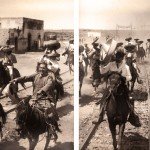 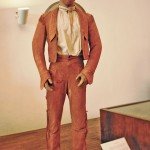 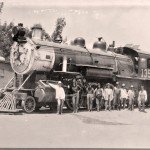 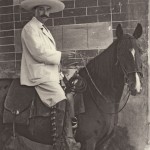
But, as you are wondering where we are going with this, enough with the heavy stuff. Those interested will look into it from the wealth of information available.
Andale.
So. To ease into this season, we have imagined some characters from our previous “Men of the Frontier” collections (Spring and Fall 2012) getting involved in the Revolución. Many thrill seekers did at the time, seizing opportunities ranging from wanting to fight oppression… to making a peso. Some were known as members of the ‘Gringo Rag-tag Battalion‘… But i’m drifting again.
Spring 2013 is not about Mariachi outfits or Cinco de Mayo costumes, but rather mixes early European tailoring influences (as worn by the Hacendados, the landed barons), with Old West-meets-Bandidos-meets-Charreria silhouettes. With a grain of salt, and à la Mister Freedom® salsa picante, but of course.
Tropical hemp-cotton textiles, fancy poplin shirting, “Baja” indigo blue woven yarns, natural earth tone slubby fabrics, pin stripes, sugar cane fibers selvedge denim… are some of the original fabrics we chose and developed for this concept. The look book for Spring 2013 can be viewed here.
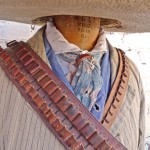 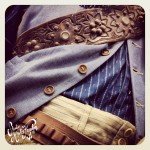 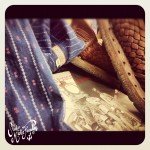 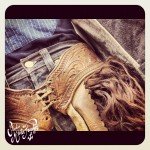 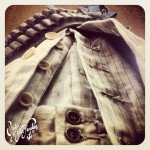 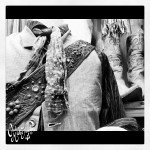 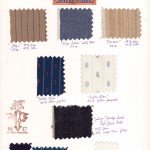
Here is what our characters will be carrying in their suitcase or saddle bags this season:
* The HACENDADO Jacket, Waistcoat and Trousers, in three original fabrics: ‘Baja Denim’, ‘Homespun’ and ‘Stripe’. (To match or not to match, that is the question.)
* The RANCHERO Shirt, in indigo calico printed poplin and dobby stripe jacquard poplin.
* The CHARRO Bib, indigo dyed and white cotton knit, with fancy bibs.
* The LOCO Jacket and VAQUERO Jeans, in indigo selvedge left hand twill denim, woven from cotton and recycled sugar cane fibers.
Stay tuned for individual description and specs of each item, posted as we receive this limited production throughout March 2013.
Señoras and Caballeros, thank you for reading.
El Jefe,
Cristóbal Loiron
😉
Some recommended reading/viewing and resources:
* “Photographing the Mexican Revolution” by John Mraz
* “War Scare on the Rio Grande” Robert Runyon’s Photographs of the Border Conflict, 1913-1916
* ” Mexico, the Revolution and Beyond” Photographs by Agustin Victor Casasola 1900-1940
* “Insurgent Mexico” by John Reed, 1914
* “The Storm that Swept Mexico” DVD documentary from Paradigm Productions Inc.
* “Viva Zapata!” Marlon Brando in a 1952 Elia Kazan movie
* “Pancho Villa, el Angel y el Fiero” DVD documentary, 2003
* Everything you didn’t know you wanted to know about Huarache sandals on this devoted blog here
|

